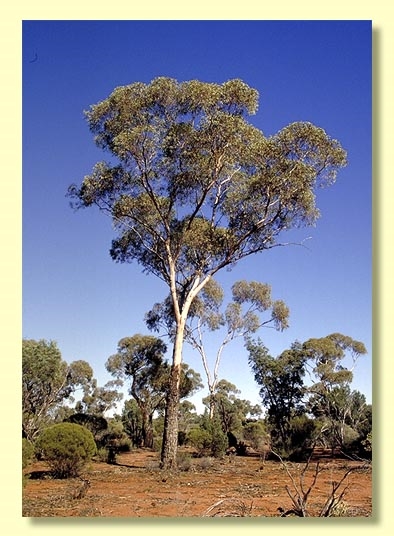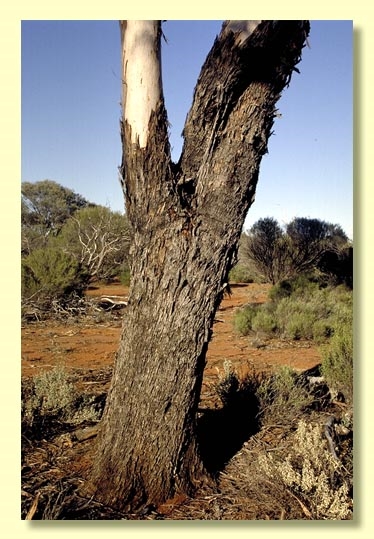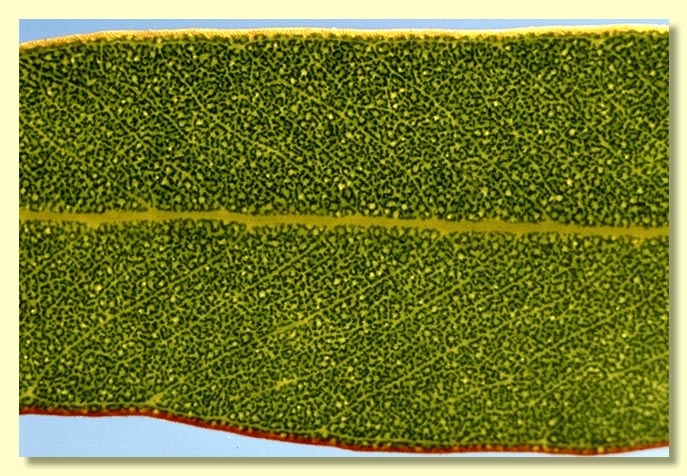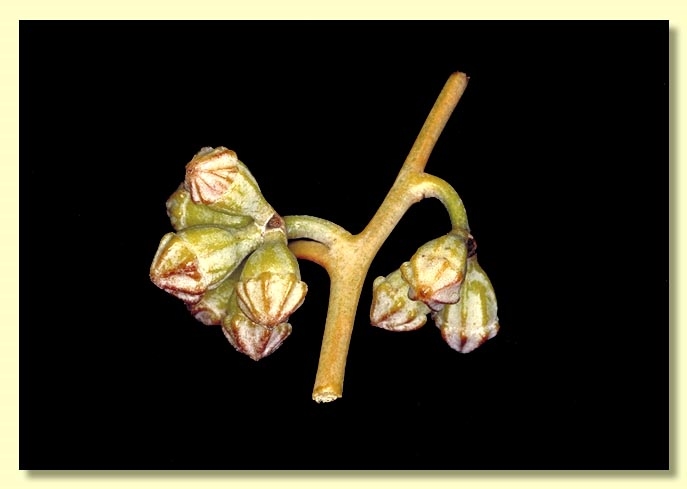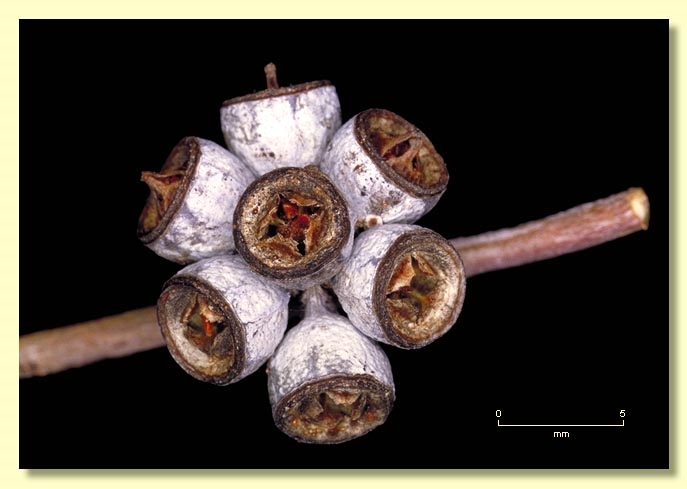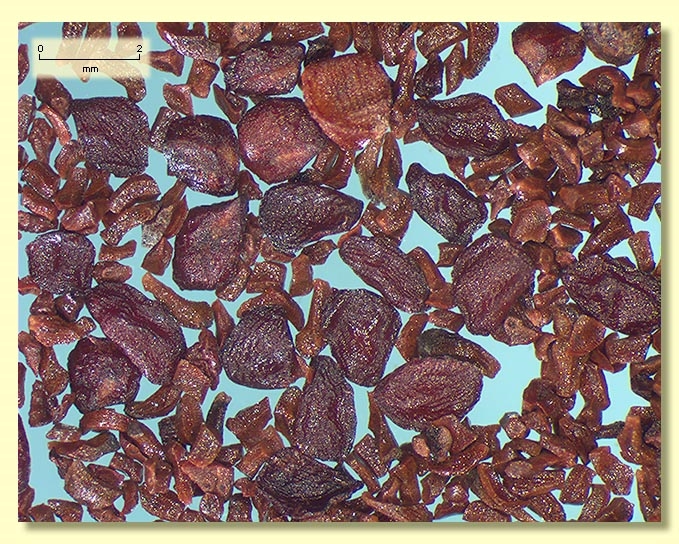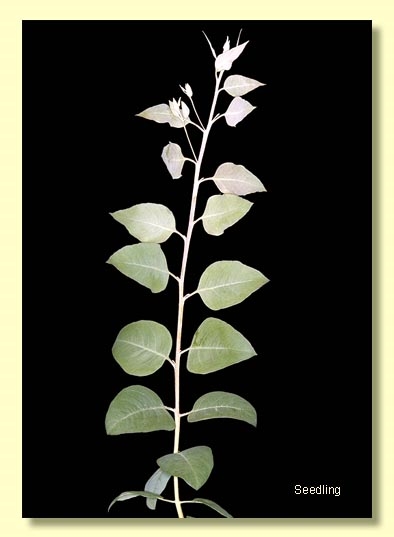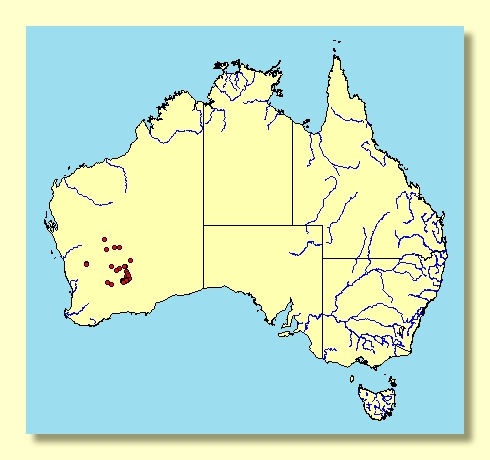Euclid - Online edition
Eucalyptus clelandiorum
Eucalyptus | Symphyomyrtus | Dumaria | Rufispermae
E. goniantha var. clelandiorum Maiden, Proc. W. Austral. Nat. Hist. and Science Soc. 3(2): 176 (1911). T: "(1) Lannin's Timber Camp, nearly 70 miles north of Kurrawang, ... (2) Goongarrie, 54 miles north of Kalgoorlie" , W.A., Sept. 1909, J.H.Maiden; lecto: NSW, fide J.H.Maiden, op. cit.; isolecto: K, L, PERTH 01377140.
Bark rough, black and hard to crumbly to flaky for up to ca half of trunk, smooth pale grey and pale orange-brown to pink-white above.
Branchlets usually glaucous, oil glands present in pith.
Juvenile growth (coppice or wild seedling to 50 cm tall): stems rounded in cross-section, glaucous; juvenile leaves always petiolate, opposite for few nodes then alternate, ovate to broadly lanceolate, to ca 8 cm long, 3.5 cm wide, base rounded to tapering, glaucous.
Adult leaves alternate, petioles 1–2.5 cm long; blade narrowly lanceolate, 8–15.5 cm long, 0.9–2.5 cm wide, base tapering to petiole, margin entire, apex pointed, concolorous, dull, grey-green to glaucous, side-veins at an acute or wider angle to midrib, reticulation dense to very dense or obscure, intramarginal vein close to margin, oil glands intersectional.
Inflorescence axillary unbranched, peduncles 0.6–1.5 cm long, buds 7, 9 or 11 per umbel, pedicels 0.1–0.5 cm long. Mature buds obovoid to ovoid (0.7–1.2 cm long, 0.4–0.7 cm wide), glaucous, scar present (outer operculum shed early), operculum usually beaked (0.4–0.6 cm long), radially striate, stamens inflexed, anthers cuboid to wedge-shaped, versatile, dorsifixed, dehiscing by longitudinal slits, style long and straight, stigma more or less rounded, locules 4 or 5, the placentae each with 4 vertical rows of ovules. Flowers white.
Fruit pedicellate (pedicels 0.1–0.6 cm long), cupular, 0.5–0.9 cm long, 0.5–0.8 cm wide, with several well-spaced longitudinal ribs or almost smooth, disc descending, valves 4 or 5, at rim level, rarely slightly exserted.
Seeds reddish brown and glossy, 1.2–3 mm long, flattened-ovoid and often angular in outline, dorsal surface very shallowly reticulate, hilum ventral.
Cultivated seedlings (measured at ca node 10): cotyledons reniform; stems square in cross-section, glaucous; leaves always petiolate, opposite for 4 to 5 nodes then alternate, ovate, 5–8.5 cm long, 2.5–5 cm wide, glaucous.
Flowering has been recorded in March, August, September and November.
A small mallet endemic to the central goldfields of Western Australia, from Southern Cross to Leinster and south to near Norseman, with sporadic populations north of Sandstone and a western outlier between Wubin and Paynes Find. The trunk has a black butt of thick rough bark with the upper trunk and branches smooth and whitish to salmon pink. Branchlets are glaucous and the adult leaves are dull, greyish green to slightly glaucous.
In the classification of Brooker (2000) Eucalyptus clelandiorum belongs in Eucalyptus subgenus Symphyomyrtus section Dumaria having these features: buds initially with two opercula the outer shed early, stamens strongly inflexed, ovules in 4 rows on the placentae and cotyledons reniform. Within section Dumaria the species belongs to a large sub-group of closely related species (series Rufispermae, 37 described species and subspecies) diagnosed by glandular pith in the branchlets, anthers cuboid to wedge-shaped, versatile, and by the reddish brown and glossy, flattish seeds which are unique to the series.
The combination of mallet habit, rough black butt, generally dull and glaucous aspect to crown, size of buds and fruit and ribbing on buds separates E. clelandiorum from all other series Rufispermae species in this area of Western Australia. The closest morphologically is E. lesouefii which a taller tree with much more prominently ribbed buds and fruit and distinctly glossy green adult leaves.
Eucalyptus clelandiorum: The epithet was originally published by Maiden as "clelandi" but he also states that the taxon was named in honour of two men with the surname Cleland. The epithet is thus corrected in APNI* to clelandiorum in accordance with ICN Art. 60.12 and Rec. 60C.1 (Melbourne Code, 2012). According to Maiden the epithet honours Mr. A.F. Cleland, Civil engineer, of Kurrawang, WA; and of Dr. J. Burton Cleland, nephew of the above, who made many botanical investigations in Western Australia before moving to Sydney.
*APNI is Australian Plant Name Index online accessed 2012 and later, https://biodiversity.org.au/nsl/services/APNI

